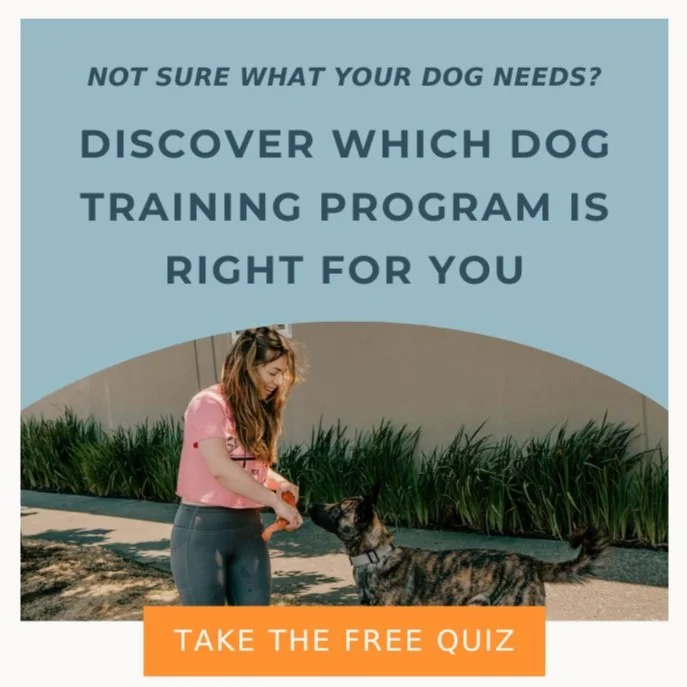5 Easy TrickS to Teach Your Dog
Trick training is one of the best ways to bond with your dog, increase their ability to learn, provide them with mental stimulation. In addition, trick training can help you to develop stronger behaviors and provide you with creative ways to reinforce your dog!
Here are five of our favorite and easiest tricks to teach your dog for the beginning of your trick training journey!
5 Easy Dog Tricks for All Dogs
1. Touch
This behavior is great for a myriad of reasons. First, you can use “touch” to teach a variety of other tricks like “up” and “off”! This behavior can also be used as a substitute for a come when called behavior since your dog has to come all the way to you to touch their nose to your hand. Lastly, you can easily move your dog from one location to another using the “touch” behavior!
Step 1: Present your flat hand for your dog to sniff. Click & treat your dog while they’re sniffing your hand. Repeat 10x.
Step 2: Say “touch” then quickly present your hand to your dog to sniff or touch with their nose. Click while your dog’s nose is touching your hand. Repeat 5-10x.
Step 3: Next session, warm your dog up with a few easy “touches”, presenting your hand directly in front of their nose, then begin to add some variety. Start to present your hand a bit to the left, a bit to the right, back a bit further, above their head, and down below so they realize “touch” means to touch their nose to your hand regardless of where your hand is!
2. Spin & Twirl
Spin & Twirl are great behaviors for teaching your dog body awareness. Most dogs don’t pay attention to where their hind ends are stepping, so spin & twirl will get your dog thinking about their back paws more. Spin & twirl can also be used to get your dog untangled from their leash, and to get them into a nice “heeling” position at your side!
Step 1: Pinch a treat between your thumb and your fingers in your right hand. Cross your body with your right arm so that your palm is facing the right side of your body. Put the treat right on your dog’s nose, and slowly lure them in a circle clockwise. Repeat 5-10x.
Step 2: Now, say “spin” then quickly lure your dog clockwise using your right hand. Repeat 5x.
Step 3: During your next session, begin to use just the verbal cue “spin” and then use your empty hand to gesture your dog into a spin. Click while your dog is about to complete the spin and treat. Repeat 5x.
Step 4: To “fade” your hand from the picture and use just a “verbal” cue, say the cue “spin” each time, then slowly use less fingers to gesture your dog, each repetition, until you’re using just your pointer finger to gesture, then raise your hand slightly above your dog’s head each repetition, until your hand is at shoulder height making the spinning gesture with just your pointer finger. From there you will say “spin” and slowly bring your hand closer to your body each repetition, until your hand is no longer in the picture and your dog responds to just the verbal cue “spin”.
Step 5: To teach twirl, follow the exact same steps, but use your left hand and prompt your dog to spin counter clockwise.
3.Middle
This is one of our favorite behaviors! We love “middle” for the safety it provides your dog. Shy or nervous dogs love “middle” because it gives them a safe space to be out in public. You can also use “middle” if you need your dog to get out of the way of people walking by on a trail or sidewalk, or if you’re standing in line paying for coffee and want to be sure your dog isn’t getting into anything!
Step 1: Using a treat squished between your thumb and four fingers, lure your dog behind you, and then using your other hand, lure them from the front in between your legs. Say “yes” when their head pops between your legs and feed them several treats. Repeat 5-10x.
Step 2: Say “middle” then lure your dog behind you and between your legs, marking with a “yes” and rewarding them while they’re between your legs. Repeat 5x.
Step 3: Say “middle” then gesture your dog behind you and between your legs, marking and then treating them while they’re between your legs. Repeat 5x.
Step 4: To fade your hand gesture out of the picture, say “middle” then begin to gesture your dog slightly less prominently by only luring your dog behind you, but not through your legs, then gesturing them just to your hip, then gesturing them just with a quick flick of your hand at the front of your body, until you do not have to gesture at all and your dog responds to just the “middle” cue. Keep in mind you will “fade the gesture” just slightly each repetition, and you should reward your dog highly for responding to each step of the process. This can take several days to accomplish!
4. Bow
Teaching your dog to bow is a great party trick, and a good way to get your dog to stretch! After a walk, get your dog to perform a few “bows” to stretch out their warm muscles and protect against future injury!
Step 1: Hold a treat between your thumb and your four fingers. Put the treat on your dog’s nose and slowly lure their nose down and back to the ground, until their elbows touch the ground. As soon as your dog’s elbows touch the ground, click and release the treat! Toss a reset treat and repeat 10x.
Step 2: Next, say “take a bow” and then lure your dog into the bowing position. Click and reward. Repeat 5-10x.
Step 3: Say “take a bow” and then gesture your dog into the bow position without a treat in your hand. Repeat 5x.
Step 4: To slowly fade your hand out of the picture, each repetition, begin to lean down less and less so that your hand is no longer touching the ground, and you are able to stand up straight while asking your dog to “take a bow” until you’re standing up straight, and do not need to gesture your dog into the bow at all.
5. Roll Over
This is one of those fun party tricks that also helps improve body awareness and muscle stretching. Not only does your dog have to think about how their weight is shifting, but they’ll also get a nice neck and back stretch while performing a roll over. After your dog’s walk, ask for a couple “roll overs” to work those muscles!
Step 1: Get your dog into a “down” position by either cueing a “down” or through luring. Click and treat your dog for the down position.
Step 2: Hold a treat between your thumb and your four fingers and put the food lure right on your dog’s nose. Slowly lure their head toward their shoulder. Click and reward your dog. Repeat 5x.
Step 3: Using a food lure, lure your dog’s head to their shoulders and slightly above their back so that their weight shifts to their side. Click and treat. Repeat 5x.
Step 4: Using your food lure, lure your dog’s head so that they shift their weight to the side, then finish the circle by luring them all the way to the other side of their body. Repeat a few times.
Step 5: Add the cue by saying “roll over” then luring them into the roll over behavior. Repeat several times.
Step 6: On a different day, or a later session, fade the food lure by saying “roll over” then gesturing your dog into the roll over position. Repeat several times.
Step 7: You can fade your gesture into a hand signal or fade it completely by saying “roll over” then using your hand make a circle gesture that starts at their nose and loops behind your dog’s neck to prompt them to roll over. Each repetition, fade your fingers out until you’re making a circle with just your pointer finger to prompt the roll over. From there you will stop circling behind your back and only make a circle prompt/gesture at your dog’s nose.
Step 8: To completely fade the gesture, begin to make your circle smaller and smaller each repetition, and gradually pull your arm into your waist.
Bonus Tip: Wear a Treat Bag to Teach on-the-go
Help encourage good behavior with this wearable treat bag. Find one with an audible click of the magnetic closure, to let your pup know they're about to be rewarded!
We love this one from Ruffwear Treat Trader because it can attach to the waist or be worn as a belt for quick access to rewards.
It's made with durable fabric and waterproof lining for less mess and features an outer pocket for small essentials like keys or pickup bags.
Highly recommend you purchase one for yourself!
REMEMBER: To ensure your dog learns these behaviors fluently, practice them first in a low-distraction environment, then teach the behaviors from scratch in several new progressively more challenging environments.
Have fun teaching your dog these new tricks & reaping the benefits of trick training!






